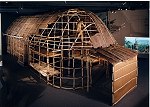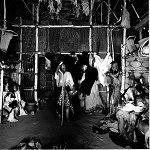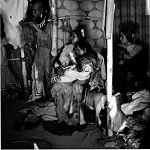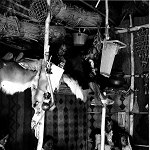A MOHAWK IROQUOIS VILLAGE - Section 2
(Click on the thumbnail image to see a larger view.)
 1. The rounded end of an Iroquois longhouse, reconstructed at full size in the New York State Museum, viewed through a gap in the palisade.
1. The rounded end of an Iroquois longhouse, reconstructed at full size in the New York State Museum, viewed through a gap in the palisade.
Four hundred years ago, an Iroquois longhouse village was typically surrounded by a palisade or "stockade." The palisade was built of tall, upright posts set into the ground, with saplings, and sometimes, sheets of bark, interwoven between them. From the inside and outside, the palisade wall resembled a wicker basket. Villages might be protected by one, two, and even three encircling rows of palisades. The palisade protected the villagers from enemy attack, and kept wild animals out, as well. Some researchers think they may have also served as a "snow fence," protecting the longhouses just inside from winter winds and snow.
One or more openings in the palisade allowed residents to pass in and out of the village. Unlike this exhibit recreation, where a gap is shown in the palisade wall, the entrance into a village was a narrow and low passageway, many feet long, between the overlapping ends of palisade wall.
Detail from A Mohawk Iroquois Village, c.1600. New York State Museum, Albany, NY.
 2. The Iroquois lashed the framework of their longhouses together with long strips of bark, and covered this frame with large sheets of bark. That is a life-sized figure working on the framework. A diorama of an Iroquois agricultural field is in the background.
2. The Iroquois lashed the framework of their longhouses together with long strips of bark, and covered this frame with large sheets of bark. That is a life-sized figure working on the framework. A diorama of an Iroquois agricultural field is in the background.
An Iroquois village was made up of one or more longhouses, which were usually that: long houses. They ranged in length from about 60 feet to well over 220 feet, and were generally about 20 feet wide and 20 feet high. The framework of a longhouse resembled a large rigid basket made of wooden posts set into the ground, with other poles and saplings lashed to these to form the exterior walls and create the arched roof. A variety of trees were used to construct the framework: decay-resistant woods chosen for the posts and poles set into the ground; strong, and sometimes flexible woods chosen for the remainder of the framework. The bark was probably peeled from these posts, poles, and saplings, so that they would be less likely to harbor insect pests.
Bark from various kinds of trees was used to cover the framework, for interior partitions, and for the benches and shelves of the living space. Among the New York Iroquois, elm bark was preferred. Large sheets of bark were lashed to the exterior walls and roof of the longhouse. The Iroquois smoothed the rough outer bark surfaces, so that water would run off of them more easily.
The Iroquois Longhouse, A Mohawk Iroquois Village, c.1600. New York State Museum, Albany, NY.
 3. A longhouse was home to an extended family where the elder women and men were the keepers of the community's traditions and histories. As "storytellers" they entertained members of their extended families, while teaching them through the spoken word, about their traditions, histories, and values.
3. A longhouse was home to an extended family where the elder women and men were the keepers of the community's traditions and histories. As "storytellers" they entertained members of their extended families, while teaching them through the spoken word, about their traditions, histories, and values.
The length of a longhouse was determined by the size of the extended family for which it would serve as a home. The interior of the longhouse was divided into a series of compartments or apartments about 20 feet long. Each compartment was the home of two families. Each family shared a fire for heating, cooking, and light, with the family that lived across the central aisle or corridor. This aisle ran the length of the longhouse from end to end, door to door. A longhouse, 220 feet long, could be the home of 18 families, or about 90 people; a longhouse of 60 feet might serve as the home of four families or 20 people. The longest longhouse known from archeological excavations was 400 feet long and was probably the home of about 36 families, or 180 people.
Everyone living within a longhouse, except the husbands, was related through the mothers' side of the family and belonged to the same clan. After marriage, husbands moved from their mothers' longhouses into those of their wives. The eldest women in the longhouse were in charge of it.
Iroquois longhouse interior detail from The Wisdom of the Elders life group set within The Iroquois Longhouse, A Mohawk Iroquois Village, c.1600. New York State Museum, Albany, NY.
 4. The longhouse was a comfortable place to live, as long as you did not mind lots of family as neighbors. Each family's "home" was on a fur- and mat-covered platform, or bench, about 5 to 6 feet wide and about 15 long, which extended along the exterior wall of the longhouse. The bench was built a foot or so above the ground.
4. The longhouse was a comfortable place to live, as long as you did not mind lots of family as neighbors. Each family's "home" was on a fur- and mat-covered platform, or bench, about 5 to 6 feet wide and about 15 long, which extended along the exterior wall of the longhouse. The bench was built a foot or so above the ground.
The bench was each family's living space: their bedroom, dining room, recreation room, and workroom. Large mats or skins could be hung in front of it for privacy, or for warmth during the cold of winter. Firewood was often stored under the bench, and one can only imagine how much firewood would be necessary for heating, cooking, and lighting in each longhouse.
About five feet above the bench was a shelf that served for storage, and made a ceiling over the bench. The space between them was closed off at the ends by partitions, which made a cozy cubicle of the living space. This arrangement formed a storage "closet" between one end of the cubicle and the end of the compartment.
Iroquois longhouse interior detail from The Wisdom of the Elders life group set within The Iroquois Longhouse, A Mohawk Iroquois Village, c.1600. New York State Museum, Albany, NY.
 5. A couple of boys find the shelf a good vantage point for listening to the storyteller.
5. A couple of boys find the shelf a good vantage point for listening to the storyteller.
Most of the information about what the inside of a longhouse looked like comes from Iroquois oral traditions and from descriptions written by European visitors to longhouses during the 1600s and 1700s. These sources tell us that the longhouse was not only packed with people, but also with the things that they made and used. Extra animal skin robes and blankets, reed mats, wood splint baskets, and clay pots used for storage or cooking, were most often kept on the shelf which served as the "roof" to their living compartments. This shelf also served as additional seating during "family meetings" or during "storytelling" on winter evenings. Depending upon how cold, or hot and smoky the longhouse was, the shelf might also be used for sleeping.
Little has survived of these longhouses. Archeologists find only indirect evidence of them in the form of dark circular stains in the ground, which they call "postmolds." These mark the places were the wooden posts of a longhouse framework were once set, but have since rotted away leaving an organic stain in the soil. Areas of fire-reddened earth, some associated with fire-cracked stones, mark the locations of fireplaces. These are commonly found along the center aisle. Other "archeological features," such as filled-in storage or garbage pits, provide additional information about longhouse life.
Iroquois longhouse interior detail from The Wisdom of the Elders life group set within The Iroquois Longhouse, A Mohawk Iroquois Village, c.1600. New York State Museum, Albany, NY.
 6. The Iroquois were farmers. Corn, beans, and squash were their main crops. If you look closely, you can find the red blossoms of the climbing bean plants and the broad leaves of the squash plants.
6. The Iroquois were farmers. Corn, beans, and squash were their main crops. If you look closely, you can find the red blossoms of the climbing bean plants and the broad leaves of the squash plants.
In the Iroquois village of 400 years ago there was a strict division of work by gender. Although men created the fields in the forest by cutting down the trees and burning the unwanted wood and brush, farming was "women's work." Women planted, cultivated and harvested the crops, assisted by their children whom they brought to the fields with them. Elderly men also might assist them in the harvest.
Corn, beans, and squash are known today by the Iroquois as "Our Life Supporters," or as "The Three Sisters." Like sisters who worked together in the fields and who shared the same longhouse living space, corn, beans and squash were often planted together in the same spot or "hill". Here they grew together and provided strength and nourishment to one another. Cornstalks provided a place for the vines of beans to climb; beans replaced some of the nitrogen in the soil, which the corn depleted; and the large, broad leaves of the squash and pumpkin plants shaded the ground, holding moisture in and discouraging weeds from growing.
"The Three Sisters" - The Growing Field, A Mohawk Iroquois Village, c.1600. New York State Museum, Albany, NY.
 7. Elderly men occasionally helped with the work in the fields. This man is scraping soft kernels of corn from the cob with a deer's jawbone.
7. Elderly men occasionally helped with the work in the fields. This man is scraping soft kernels of corn from the cob with a deer's jawbone.
Although the main harvest took place in the fall, another important event in the farming cycle was "Green Corn" time, usually sometime in August, when the corn was "green" or not fully ripened. Similar in consistency to our sweet corn, the green corn was harvested for immediate consumption. This occasion was one of the Iroquois' important seasonal ceremonies of thanksgiving.
Much of the interior of the longhouse was taken up with food storage, especially corn, beans, and squash, which were harvested in the fall. Dried ears of corn, their husks folded back and braided into long "ropes," hung from the longhouse rafters. Shelled corn and beans were stored in large bark barrels placed in the storage rooms at either end, near the entrances to the longhouse. Slices of dried squash and pumpkin hung from sticks also suspended above, where the heat would dry them and smoke would help to preserve them.
Detail from "The Three Sisters" - The Growing Field, A Mohawk Iroquois Village, c.1600. New York State Museum, Albany, NY.